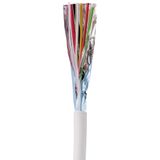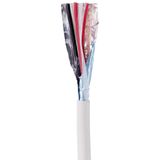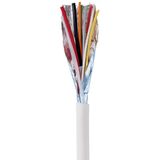Vimar Fireproof cables




vimar fibre optic cables portfolio and CPR classes
The core family includes tight-buffer indoor, distribution 6–24F, breakout 2–12F, micro-duct blown fibre, and armoured routes for plant areas, all in PVC or LSZH with Eca…Cca-s1,d1,a1 options. Reels print DoP ID, batch, and metre marks. Teams choose vimar fibre optic cables when they want consistent OD windows that match Vimar glands and splice hardware.
vimar singlemode fibre cables long runs and campus links
OS2 G.652.D for standard risers and G.657.A2 where tight bends are unavoidable; typical attenuation 0.34 dB/km @1310 nm and 0.20 dB/km @1550 nm, macrobend-safe down to 10–15 mm radii on bend-insensitive cores. For rooftop or car-park spans, pick PE/UV jackets and dielectric armour. Designers specify vimar singlemode fibre cables when 10–25G backbones or PON overlays need headroom without later recabling.
vimar multimode fibre wiring floor spines and server rooms
OM3/OM4 tight-buffer links cover SR optics to 300–550 m with modal bandwidth 1500–3500 MHz·km. Orange/aqua/violet jackets keep estates readable; breakout tails terminate straight into LC cassettes. Where racks run hot, low-smoke jackets and documented bundle temps protect certification. Specifiers tag vimar multimode fibre wiring to fast-track patching for meeting rooms, AV matrices, and storage clusters.
vimar fiber optic patch cords assemblies and polarity control
Simplex/duplex LC/SC in UPC/APC, uniboot low-OD cords for dense fronts, and MTP/MPO fan-outs to LC for switch uplinks. Factory test sheets show insertion loss (≤0.3 dB LC/SC, typical), return loss (UPC ≥50 dB; APC ≥60 dB). Polarity A/B and key-up/key-down rules are printed on bags so vimar fiber optic patch cords drop in without rework.
vimar optical communication cables constructions and environments
Distribution cables minimise OD for crowded channels; breakout builds add 900 µm legs for direct connectorisation; micro-duct units support staged capacity; steel-tape or glass-yarn armour resists rodents and impacts. Published crush (>1000 N/10 cm) and tensile ratings simplify pull planning—one reason planners adopt vimar optical communication cables for mixed office/industrial estates.
vimar data fiber cables trunks, cassettes, and racks
Pre-terminated trunks (12F/24F) with pinned/unpinned MPO, plus LC/SC cassettes that snap into Vimar panels, accelerate go-live. Label windows match the brand’s numbering strips, and slack managers keep 10×OD radii. Network teams order vimar data fiber cables with cassette maps so SFP/SFP+ ports align one-to-one with rack coordinates.
vimar network optical lines design, testing, and documentation
Loss budgets cover connector count, splice loss, and patch churn; OTDR baselines are stored at handover; MAC work follows the same tray and divider rules as power/SELV. Acceptance packs list link IDs, fibres used/spare, and measured IL/RL. Facilities reference vimar network optical lines in method statements to lock pathway fill, bend guides, and gland threads.
Product range and series overview
• Bulk cable: tight-buffer indoor, distribution 6–24F, breakout 2–12F, micro-duct, armoured indoor/outdoor.
• Connectivity: LC/SC cassettes, unloaded/splice panels, splice trays, pigtails, fan-outs, field-fit connectors.
• Pre-terms: MPO trunks 12/24F, LC/SC pre-terminated whips with pull eyes and test sheets.
• Accessories: through-floor grommets, bend-radius guides, shield/earth kits, labels matching Vimar racks and plates.
Technical specifications and standards that matter
Optical fibre: ITU-T G.652.D and G.657.A2 (OS2); ISO/IEC 11801-1 and EN 50173 channel models. Multimode: OM3/OM4 per IEC 60793-2-10; connectors to IEC 61754 (LC/SC), MPO to IEC 61754-7. Reaction-to-fire per CPR EN 50575 with DoP; LSZH to IEC 60754/61034. Install limits: bend radii fibre ≥10×OD installed (tighter per G.657.A2), pull tension per datasheet; temperature −20…+60 °C typical indoor. Document polarity, connector count, and splice types in the O&M set.
Applications and compatibility
• Offices/hospitality: OM4 floors, OS2 risers, LC cassettes in Vimar panels; low-OD uniboot cords in meeting rooms.
• Education/healthcare: bend-insensitive OS2 in tight channels, LSZH everywhere people evacuate.
• Logistics/industrial: armoured distribution in trays near drives, dielectric pulls through metallic conduits for EMC.
All parts align with Vimar conduits, trunking, racks, and Eikon/Arké/Plana plates so outlets, labels, and bend guides match.
Selection criteria for B2B buyers
- Fix service mix (LAN core, AV, security backhaul), then select OS2 or OM3/OM4 and connector type.
- Choose construction by route: distribution for density, breakout for direct terminations, armoured where impact/rodents exist.
- Lock CPR class, jacket (PVC vs LSZH), OD limits for chosen trunking, and minimum slack (≥1 m in racks, ≥300 mm in boxes).
- Publish loss budget, polarity, MPO pinning, and test regime (OLTS/OTDR).
- Room-bundle: cable, cassettes, cords, labels, and grommets by rack and floor so commissioning is one pass.
Advantages of working with Bankoflamps
We sequence deliveries to your fibre pull schedule, issue job-specific pricing, and return quotes by EAN/MPN quickly with live EU stock shown before crews are booked. The portal tracks lead times, shipments, and provides downloadable price lists with validity windows you can plan around. Trusted buyers can use post-payment up to 30 days. We consolidate partials so trunks, cassettes, cords, splice gear, glands, and labels arrive route-bundled by riser, and your account manager cross-checks CPR classes, OD/bend limits, polarity maps, and test scripts against drawings—keeping estates site-ready across France, the Baltics, Germany, Spain, Italy, Belgium, and the Netherlands.